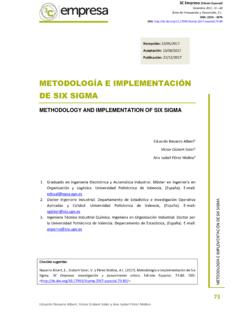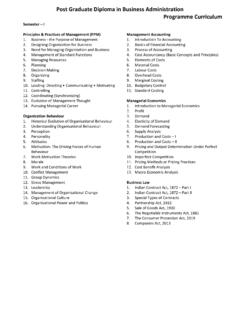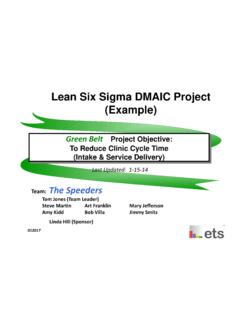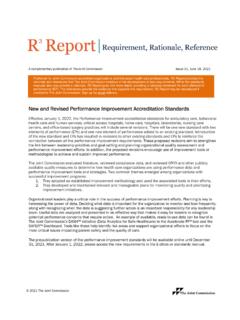Transcription of Lean Six Sigma: some basic concepts - NHS England
1 Institute for Innovationand ImprovementLean Six sigma : some basic conceptsIntroductionBy Helen Bevan, Neil Westwood, Richard Crowe, Michael O' English National Health Service (NHS) is the largest healthcare system in theworld. Its annual budget is more than 70 billion and it employs million year, there were 325 million patient consultations with primary care physiciansand nurses. More than 13 million people attended a first specialty appointment inhospital and 14 million people attended the Accident and Emergency department(Chief Executive s report to the NHS, 2005).The NHS is in the middle of a 10 year programme of transformational change. The aim is to provide a health and healthcare service that meets the life-long needsof the citizens of England . Ambitious goals have been set to reduce the burden ofdisease and improve outcomes of care: to reduce hospital admissions by supportingpeople with long term conditions in managing their own care and by providingpreventative, community-based services; to improve clinical quality and safety; toimprove access to care, remove health inequalities and eliminate mission requires multiple improvement strategies on multiple fronts.
2 On onelevel, it requires nothing less than fundamental redesign of the healthcare system. At another level, it needs on-going incremental improvement of existing services. We have tested and utilised a wide range of improvement strategies in our quest tocreate faster, more effective change. This has included Lean and Six sigma , both ofwhich have delivered promising results, particularly when combined with other toolsand techniques. Pioneers are undertaking early testing of the approach. Our latestendeavour involves the integration of the two into an approach we have labelled Lean Six sigma for healthcare . This paper sets out some of the principlesunderpinning the Institute for Innovation and Improvement Lean Six sigma : some basic concepts1 Lean Six sigma an overviewLean is an approach that seeks to improve flow in the value stream and eliminatewaste. It s about doing things sigma uses a powerful framework (DMAIC) and statistical tools to uncover rootcauses to understand and reduce variation.
3 It s about doing things right (defect free).A combination of both provides an over-arching improvement philosophy thatincorporates powerful data-driven tools to solve problems and create rapidtransformational improvement at lower key is to find the optimal combination of both approaches. For example,adopting the Lean idea of focusing on what adds value and then using Six Sigmatools to help understand and reduce variation, when the value stream is agreed. This figure below shows the roots of Lean and Six sigma and how they , organisations from many industries, including healthcare are adopting a Lean Six sigma strategy. This is particularly true of organisations that previouslyfocused on Six sigma . General Electric, one of the pioneers of Six sigma , is nowincorporating a Lean Six sigma approach to achieving rapid transformational changeat lower 1 History of Lean and Six sigma adapted from Institute for Innovation and Improvement Lean Six sigma : some basic concepts2 Lean<19601970 s1980 s1990 s2000 s2010 sLean Six SigmaSix SigmaTaiichi OhnoToyota ProductionSystemJust in timeLean ProductionLeanEnterpriseDemingQuality Improvement ToolsReduce Variation TQMSix SigmaMotorolaQualityFocusIntroduction to LeanLean principles have been enhanced and developed by Toyota to create the ToyotaProduction developed Lean in the 1950s based on the work of Frederick Taylor and Deming, both industrial engineers.
4 (Note, Toyota does not refer to the wordLean, it uses the Toyota Production System. See Table 1.)Stephen Spear s paper in Harvard Business Review (2005) says If one asks thequestion, can the Toyota Production System be applied in healthcare? The quickanswer is yes. Industrial engineers invented both Lean techniques and the Six sigma approach toprocess quality. Lean is a strategic approach to change and improvement. Focusing just on the toolsat an operational level and reducing costs, will not obtain the full benefits. Lean means using less to do more by determining the value of any given processby distinguishing value added steps from non value added and eliminating waste sothat ultimately every step adds value to the process (Miller, 2005).It is relentlessly focused on the work and by definition the strategy becomes: focuson the work, learn from it and improve. That s your strategy. The strategy is simplyto learn.
5 Not understanding Lean and applying tools in isolation leads it to be a cost-reductionexercise. The main criticisms of Lean are summarised as (Hines et al., 2004): lack of consideration for human factors lack of strategic perspective (at least until recently) relative inability to cope with variability Lean means laying off people Lean is only for manufacturing Lean only works in certain environments but it is more than manufacturingprocess design (a strategic approach). Table 1 Evolution of the Lean approach Boaden, 20051980-90 Cell and LineHighly prescriptivetool-based approach,disseminating thetools used by Toyotaand others1990-mid 1990 Shop FloorHighly prescriptivebest practiceapproach, with afocus on qualityMid 1990-1999 Value StreamLean principlesValue concept of theLean Enterprise witha focus on quality,cost and of one best way stillprominent whatwould Toyota do? 2000+Value SystemContingencyinvolving customervalue, policydeployment, size, industry, technologyfocusing on system-level capability andintegrated processesNHS Institute for Innovation and Improvement Lean Six sigma : some basic concepts3 Introduction to Six SigmaSix sigma is a process improvement methodology developed at Motorola in the1980 s to reduce defects in its processes.
6 Its goal was to achieve a level ofperformance equal to a defect rate of defects per million opportunities this is avirtually defect free environment Six sigma , Motorola Inc. Six sigma methodology emerged in the 1980s from TotalQuality Management, a core element of industrial engineering. The roots of Six sigma as a measurement standard can be traced back to CarlFrederick Gauss (1777-1855) who introduced the concept of the normal curve. Six sigma as a measurement standard in product variation can be traced back to the1920's when Walter Shewhart showed that three sigma from the mean is the pointwhere a process requires correction. Many measurement standards (Cpk, ZeroDefects, etc.) later came on the scene, but credit for coining the term "Six sigma "goes to a Motorola engineer named Bill Smith. The main criticisms of Six sigma are summarised as (Hines et al., 2004): system interaction not considered uncoordinated projects processes improved independently lack of consideration for human factors significant infrastructure investment required over detailed and complicated for some tasks it is the new flavour of the month the goal of Six sigma ( defects per million opportunities) is absolute but this isnot always an appropriate goal and does not need to be adhered to rigorously it is only about quality.
7 Lean and Six sigma are process based improvement methodologies. Both weredeveloped in manufacturing environments. Both have proven their of both can point to numerous, and dramatic success stories. Current emerging trends are indicating that integrating the best elements of bothmethodologies could help healthcare deliver strategic and operational Institute for Innovation and Improvement Lean Six sigma : some basic concepts4 Question: What are the advantages of integrating Lean and Six sigma ?Answer:Integrating Lean and Six sigma creates a win win situation. The philosophyof Lean provides the strategy and creates the environment for improving flow andeliminating waste. Empowered staff are encouraged to continuously improve tocreate value adding opportunities that otherwise would not be identified. Six Sigmahelps to quantify problems, makes evidence based decisions (this prevents wastingtime on anecdotal evidence), helps to understand and reduce variation and identifiesroot causes of variation to find sustainable solutions.
8 Furthermore, it quantifies thefinancial benefits and savings. This helps to focus efforts in the areas that offer themost potential for combination of both can provide the philosophy and the effective tools to solveproblems and create rapid transformational improvement at lower cost. Potentially,this could increase productivity, improve quality, reduce costs, improve speed, create asafer environment for patients and staff and exceed customer 2 Integrating the twoimprovement approaches Juran InstituteNHS Institute for Innovation and Improvement Lean Six sigma : some basic concepts5 Lean- focuses on dramatically improving flow in thevalue stream and eliminating wasteImproved efficiency and speedImproved effectivenessSix sigma - focuses on eliminating defects and reducing variation in processesSpecifyValueUnderstanddemandFlo wLevelPerfectionDefineMeasureAnalyseImpr oveControlQuestion: How are Lean and Six sigma similar?
9 Answer:Lean and Six sigma are both customer-focused process improvementmethodologies. They both follow the traditional quality improvement steps:1. Identify the project a. Nominate projectsb. Evaluate projectsc. Select a projectd. Ask: Is it quality improvement?2. Establish the projecta. Prepare a statement of goalsb. Select a teamc. Verify the statement of goals3. Diagnose the causea. Analyse symptomsb. Confirm or modify statement of goalsc. Formulate theoriesd. Test theoriese. Identify root cause(s)4. Remedy the causea. Evaluate alternativesb. Design remediesc. Design controlsd. Design for culturee. Prove effectivenessf. Implement5. Hold the gainsa. Design for effective quality controlsb. Foolproof the remedyc. Audit the controls6. Replicate results and nominate new projectsa. Replicate the project resultsb. Nominate new projectsAs we can see in Table 2, both Lean and Six sigma uncover similar SigmaLack of customer focusLack of customer focusLack of staff empowermentInadequate measurement systemsUntidy, inefficient work spacesSuboptimal processesSuboptimal maintenance practicesDefect opportunitiesLack of cross-trainingOutdated processes and metricsExcess inventoryLack of ownership of processesLack of visible controlsSuboptimal processesTime trapsOutdated processes and metricsTable 2 A comparison of commonproblems identified by Leanand Six sigma NHS Institute for Innovation and Improvement Lean Six sigma : some basic concepts6 Question: How are Lean and Six sigma different?
10 Answer:At one level, both Lean and Six sigma are improvement as you investigate further, the contrasting aspects of the two approachesbecomes apparent. Lean is often seen as an efficiency approach which focuses on improving flow in thevalue stream and eliminating waste. It is more than is a philosophy, not simply an exercise in eliminating waste. Lean is much morethan episodic Kaizen (rapid improvement) events, it is a continuous improvementapproach. It asks the question, Why does this process exist at all? What is the value and thevalue stream? Six sigma , by contrast, is often considered an effectiveness approach which focuseson the elimination of defects and reducing variation. It is seen as working best in anenvironment where there is variation. Six sigma starts with How can we improvethis process? It does not ask Why does it exist at all?Six sigma is not just statistics, in its best incarnation; one integrates experience,historical, prospective, and data to make decisions.

















